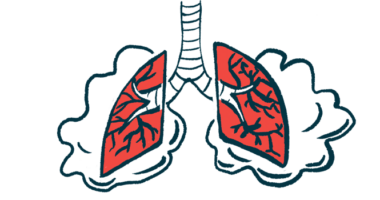Vertex Planning Phase 3 Trials in New Triple Combo Therapy for CF

Den Rise/Shutterstock
Vertex Pharmaceuticals is initiating two Phase 3 clinical trials into the safety and efficacy of a potentially new, next-generation triple combination therapy for cystic fibrosis (CF): VX-121 plus tezacaftor and VX-561 (deutivacaftor).
Expected to begin later this year, the development program will compare this once-daily therapy with Vertex’s Trikafta, also a combination of three CF medicines — elexacaftor, tezacaftor, and ivacaftor — taken daily. The investigative treatment has shown a potential “to drive higher levels of chloride transport” in cells, the company reported in a press release.
Trikafta, first approved for CF patients 12 and older, was recently expanded to treat children starting at age 6. Mutations in CFTR, the cause of CF, impair the flow of water and chloride ions in and out of cells of the lungs, pancreas, liver, and intestine. The most common is known as F508del.
“Trikafta has demonstrated high levels of efficacy in people with CF who have at least one F508del mutation,” said Carmen Bozic, MD, executive vice president of global medicines development and medical affairs, and chief medical officer at Vertex. “However, we remain committed to continuing our efforts to maximize the benefit and convenience we can deliver for these patients.”
Both VX-121 and tezacaftor are designed to enhance the amount of mature CFTR protein at the cell surface, while VX-561 aims to boost CFTR function at the cell surface.
The new therapy’s potential was first seen in experiments using human epithelial cells that line the airways. Higher levels of chloride transport were evident with VX-121/tezacaftor/VX-561 relative to Trikafta.
This Phase 3 program comes on the heels of a now-complete Phase 2 clinical trial (NCT03912233) that tested the investigative combination in CF patients ages 18 and older, with either one F508del mutation and one minimal function CFTR mutation or two F508del mutations.
The regimen was reported to be well-tolerated, and the study to meet its primary goal of improved lung function. It also met a secondary trial goal of reducing sweat chloride, whose high levels are a hallmark of CF.
A total of 10 adults with one F508del and one minimal function mutation were randomly assigned a placebo while 48 others were treated with 100 mg of tezacaftor, 150 mg VX-561 and increasing doses of VX-121, with each dose (5, 10, or 20 mg) given to a subgroup of these patients.
At the two highest VX-121 doses, lung function significantly improved compared with placebo after 29 days of treatment, as measured by forced expiratory volume (how much air a person can forcibly exhale) in one second. At all doses, the therapy also significantly lowered chloride levels in sweat, in a dose-dependent manner, by 42.8 to 49.5 millimole/L.
In patients with two F508del mutations, 10 were randomly assigned to 100 mg tezacaftor and 150 mg ivacaftor as an active control group, while 18 others were given tezacaftor and VX-561 with a 20 mg dose of VX-121. After 29 days, lung function was again reported to significantly improve in this patient group relative to the active control group, the sweat chloride levels dropped 45.5 millimole/L compared with levels before treatment.
Full Phase 2 trial data will be released at a later date, Vertex stated in its release.
Two new 48-week Phase 3 trials are now being planned to evaluate the safety and efficacy of VX-121/tezacaftor/VX-561 against Trikafta. The first study expects to enroll about 350 CF patients, ages 12 and older, with one F508del mutation and one minimal function mutation. The second will recruit 450 patients, again ages 12 and older, who carry two F508del mutations, or one F508del mutation and a second mutation responsive to CFTR modulators.
Both studies will have as their main goal an improvement in lung function that is similar (non-inferior) or superior to Trikafta.
The VX-121/tezacaftor/VX-561 regimen has been granted fast track and orphan drug designations as a potential CF treatment, which facilitate further clinical development and expedite regulatory approval.
On its own, VX-561 was also evaluated in a dose-ranging Phase 2 study. Data from this study will also be presented at a later date.
“With this once-daily, next-in-class, triple combination regimen, our goal is to develop a more effective treatment regimen with the potential to restore CFTR function in people with CF to even higher levels than currently achievable,” Bozic said.
Trikafta is also being evaluated in an ongoing and open-label (no placebo group) Phase 3 clinical trial (NCT04537793) in young children with CF, ages 2 to 5, with two F508del mutations or one F508del mutation and one minimal function mutation. This study may still be enrolling up to 84 eligible pediatric patients at sites across the U.S.; it is due to conclude in May 2022.







